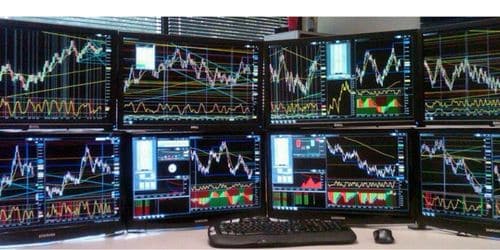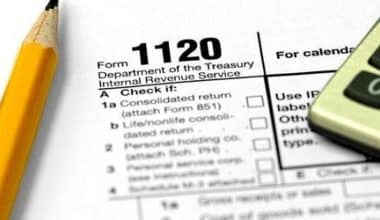Some people imagine successful day traders as multimillionaires lounging in a beach town making trades and relaxing. That is a rare occurrence, and day trading is not as simple or lucrative as it may appear from the outside. Despite the challenges, some people choose to day trade as a part-time job or as their full-time job. Day trading can make you money over time if you know what you’re doing and stick to a strategy.
If you’re intrigued by the concept but don’t know how to get started as a day trader, we’ll walk you through the process. We spoke with experts about the benefits and risks of day trading, and they shared advice on how to break into the industry. Read on to learn how to become a day trader.
Who Is a Day Trader?
A day trader is someone who opens and closes positions during the trading day rather than holding them for longer periods of time. Within a single day, trade time spans can range from a minute to an hour or several hours.
Rather than focusing on a company’s fundamentals, day traders focus on technical charts that show what the stock price is doing now and how the price has historically behaved under certain conditions.
According to Gust Kepler, CEO of trading software company BlackBoxStocks, a day trader might buy a position in a bankrupt company simply because there is an uptrend on a particular day (ticker: BLBX).
Why Should You Consider Becoming a Day Trader?
People are drawn to day trading because they see a friend making money, according to Nigam Arora, CEO of The Arora Report.
Successful day traders can make more money working a couple of hours a day from home on their laptop in the morning than they would at a 40-hour-per-week job, according to Kepler.
“People who learn how to do it can be very profitable,” he says.
What are the Risks of Day Trading?
Although there are some successful day traders, the majority of people fail.
Kepler estimates that only about 15% of people who try day trading success, and he believes that figure is likely to be high because, as a trading software provider, he sees many success stories.
According to Arora, the figure is much lower, with only 1% to 2% becoming successful.
The risk of day trading long positions in stocks is that “you lose all your money,” according to Arora. “You can lose even more if you try to short the market; your downside risk is unlimited.”
Day traders face the risk of not making enough money to cover the additional transaction costs associated with making a higher volume of trades.
“Academic studies on day traders around the world consistently find that the vast majority of day traders fail,” says Creighton University finance professor Robert Johnson. “The main point was that trading is dangerous to your wealth.”
Day trading can also pose a psychological risk if combined with a gambling mindset, which can lead to addiction. Some people get a rush of dopamine from gambling and high-risk stock trading. When the incentive becomes the dopamine-induced rush itself, investors become stock market gamblers.
“Day trading is no more likely than a roulette wheel or a blackjack table to make you rich,” says Aaron Sherman, president of Odyssey Group Wealth Advisors. “And, similar to gambling, the more you do it, the more likely you are to lose.”
Day Trading Requirements
A brokerage account is required to begin day trading stocks. Brokers are individuals or businesses that charge fees for executing trades on behalf of their clients.
Day traders are likely to go the DIY route, preferring an online brokerage account or discount broker that allows investors to buy and sell investment securities through the broker’s website or app.
The brokerage may also provide a trading platform that displays real-time news, allows traders to view technical charts and scans which stocks are making the most moves.
Depending on the asset being traded, some platforms enable investors to place online trades directly with a brokerage for a fraction of the traditional cost or for free.
DIY investors can use a discount or online brokerages such as Charles Schwab Corp. (SCHW), Fidelity Investments, TD Ameritrade, or E-Trade. Raymond James Financial (RJF) and Edward Jones are two examples of full-service brokers.
Read Also: Easy To Learn Trading App: Why Is NAGA Your First Choice?
Once you’ve chosen a broker, the Financial Industry Regulatory Authority, or FINRA, will consider you a pattern day trader if you fund your account with $25,000 and make four or more open-and-closed stock trades within five business days – and those trades must account for more than 6% of your total trading activity during that time period. This is regardless of the brokerage’s account minimum, which may be zero dollars but applies only to customers who trade less than pattern day traders. There are also special margin requirements to consider for pattern day trading accounts.
However, as a day trader, that large sum of money can work to your advantage. When it comes to transaction costs, you can make more money and get more bang for your buck if you can afford to buy higher-priced stocks or larger chunks of lower-priced equities.
If you do not want to keep a $25,000 balance, you must make three or fewer stock trades with the same broker in five days, trade in an international market, join a day trading firm that requires a smaller deposit, open multiple accounts with different brokers, or trade forex, futures, or options.
How To Become a Successful Day Trader
These pointers may be useful to both experienced and inexperienced day traders.
#1. Conduct a personal audit.
If you want to pursue day trading, you must first understand the difficulties. You will have days when you lose money. It will take some time to understand what you’re doing. Even if you understand all of the different strategies and terminology, you may not be successful. Day trading is difficult, and there is no guarantee of profit.
“Becoming a day trader is something that many people see as a simple way to make money, where you don’t need much experience – just click a few buttons and you’re rich!” “However, nothing could be further from the truth,” said Deeyana Angelo, managing director at Blahtech and Market Stalkers. “Day trading is a very difficult performance discipline, similar to becoming a professional football player or mastering a musical instrument.” You must first have a natural talent, which must be followed by years of practice.”
Day trading, according to Angelo, who has over a decade of experience in derivatives trading, is a difficult task. She stated that it requires an analytical mind and that many of the people she has seen succeed come from industries that require years of schooling and practice. If you want to become a day trader in order to become wealthy overnight, you will end up losing a lot of money. Becoming an effective day trader takes time and practice.
Having said that, there are some day-trading success stories. It is possible to be a successful day trader if you understand a market and develop effective trading strategies.
#2. Investigate the market, its strategies, and potential platforms.
Before you can become a day trader, you must first understand how the forex market, the stock market, or any other marketplace works. There’s a misconception that day traders will make you rich quickly and allow you to spend the majority of your time relaxing, but this couldn’t be further from the truth. It takes a lot of research and effort to succeed as a day trader.
Learning from successful day traders is also required when researching the market and eventually developing strategies.
“The best way to become a profitable day trader is to learn from successful day traders,” Bond says. “While there is an abundance of theoretical material on the internet about how to day trade, nothing beats learning from someone who is currently successful at it.”
Your research should also include obtaining additional information on trading strategies in that market as well as regulations governing day trading. The FINRA website is a good place to get detailed regulatory answers about day trading.
#3. Begin small.
As Rothfeld suggested, once you’ve done enough research, you should start small. It takes time to learn how to become a day trader, and putting a lot of money on the line at first is a big risk. Because day trading involves risk, you should only invest money that you are willing to lose.
According to the SEC’s website, “day traders typically suffer severe financial losses in their first months of trading, and many never graduate to profit-making status.” “Given these results, it’s clear: Day traders should only gamble with money they can afford to lose.” They should never use money that they need for daily living expenses [or] retirement to take out a second mortgage or day trade.”
Because losing money is an inevitable part of the learning process for many day traders, it’s best to start slowly and learn as you go. It’s also critical to stick to whatever trading strategy you’re using. One of the most common mistakes day traders make is developing a well-thought-out strategy only to completely disregard it in a hurried trade.
“Day traders will frequently take trades because they are just sitting in front of their screen all day,” Rothfeld explained. “A forced trade is almost always a losing trade.” Always stick to your rules.”
#4. Understand the risks and difficulties associated with becoming a day trader.
Day trading is not easy, and there are several areas of complexity that new day traders must research. If you decide to become a day trader, you should understand that it is not a get-rich-quick scheme. You will lose money along the way, and not all of your trading strategies will be profitable.
To be a successful day trader, you must be willing to put in months or years of hard work to understand the markets, develop a strategy, and consistently execute your plan over time.
How To Determine the Best Day Trading Stocks?
In day trading, the only guarantee is that you will lose money. Still, if you want to make a profit, you must conduct a thorough market analysis. Consider the following methods when analyzing a stock.
#1. Price-to-Earnings (P/E) Ratio
A company’s P/E ratio can provide insight into its growth potential in comparison to competitors in the same industry. It is calculated by comparing a stock’s current trading value to its earnings per share over the previous 12 months. A company with a current value that is ten times its earnings is considered stronger than a competitor with a stock value that is two times earnings.
#2. Price-to-Earnings Growth (PEG) ratio
The PEG ratio can assist you in determining how a company will grow over the next year or two. It is calculated by comparing the stock’s P/E ratio to the company’s expected earnings growth. The higher the PEG ratio, the greater the company’s potential for growth.
#3. Debt-to-EBITDA Ratio
A debt-to-EBITDA ratio can indicate whether a company is a high-risk investment. A high debt-to-EBTIDA ratio indicates that the company’s debt is growing faster than its earnings before taxes, interest, depreciation, and amortization. A lower debt-to-EBITDA ratio indicates that a company is less risky.
If you’re not sure how to use these strategies, pick two to three stocks you like based on their fundamentals (don’t overthink it) and track them for a quarter. What happened, and was it unexpected? What differences did you notice in stock prices? So, what influenced them? Take notes.
Consider the most important fundamental factors after tracking these stocks. When analyzing any stock, start with these factors.
Strategies for Day Trading
We discovered the following trading strategies that are frequently recommended or used by experienced day traders:
#1. Breakout:
A breakout strategy refers to a significant fluctuation, or breakout, in the price of a stock that has been relatively stable for a long time. For example, if a stock has been trading between $30 and $31 for three weeks and suddenly begins to dip or rise dramatically, it may be a good time to trade. A day trader should find that volatility appealing.
#2. Scalping
Scalping means selling your stock as soon as the trade becomes profitable. When it comes to selling, this isn’t too complicated; it’s a simple way to get your feet wet with day trading. Scalping is also known as profiting from “the spread,” because traders profit from the difference between the seller’s asking price and the buyer’s offer.
#3. Momentum trading
Momentum trading is based on current news and information. Day traders use news events to forecast rising and falling stocks, whether it’s a new earnings report or different breaking news. It takes some research to do well, but it’s still a good option for beginners.
#4. Fade:
Fading is acting in the opposite direction of the market’s current trend. It is a high-risk strategy that goes against common sense. Is everyone investing in a stock that you believe will fail? Why not sell it when it’s at its peak? Of course, the risk is that conventional wisdom can be a powerful factor in the stock market.
There are numerous other strategies and nuances you can employ as you gain experience in day trading.
Day Trading Platforms
In addition to understanding regulations and developing a strategy, it is critical to find an online broker with comprehensive trading tools. Day trading necessitates a lot of quick decisions, so you don’t want to be hampered by poor online tools, a slow internet connection, or any other technological problem. Commissions on trades may apply depending on the online trading platform you use. According to The Motley Fool, which used TD Ameritrade as an example, trading 30 times per day for 250 trading days would result in more than $50,000 in commissions over the course of a year.
Depending on the platform, you may need to make thousands of dollars to break even on your day trading. When deciding which platform to use for day trading, research is extremely important. In our research, we discovered the following top-day trading platforms:
- Interactive Brokers Inc.
- TD Ameritrade Inc.
- Ally Investment
- Schwab, Charles
- TradeStation
Platforms vary, and there are plenty of other options that draw good reviews and have strong reputations. When choosing an online trading platform, it’s critical to read customer reviews and find a reputable company that meets your requirements.
When Is the Best Time to Trade During the Day?
Generally, most activity occurs around 10:30 a.m. ET, approximately one hour after the market opens. Later in the day, the market usually settles down and becomes less volatile. Day traders make money by buying low and selling high, so the less volatile the market, the less appealing it is to day traders. Of course, every market day is different, and there may be extenuating circumstances that contribute to volatility in the afternoon as well.
How Much Money Can You Make Day Trading?
The amount of money a day trader can make is determined by market fluctuations and their positions. At any given time, day traders could make or lose a significant amount of money. When investing in the stock market, there are no guarantees of profit, especially in the fast-paced world of day trading.
How Much Capital Do You Need to Begin Day Trading?
In theory, you only need enough money to buy one stock. Regardless of how unrealistic this hypothetical example is, if you were extremely lucky, you could turn that one stock into a fortune. In reality, day traders frequently lose money before making a profit. As a result, it is best to invest only your spare cash in day trading activities. Day trading with retirement funds or borrowed funds is never a good idea.
Conclusion
Websites and courses that promise foolproof day trading success or endless profits should be avoided by aspiring traders. A small percentage of successful day traders do so by devoting time and effort to developing trading strategies and adhering to them religiously.
In this big trading world, day traders are on their own. Before quitting your job to become a day trader, make sure you have the drive to constantly learn, design your trading strategies, and accept responsibility for your decisions and actions. If you want to get started with day trading, you can use one of the best stock brokers for day trading.
How To Become a Day Trader FAQs
How much does a average day trader make?
Day traders in the United States earn an average of $116,895 per year or $56 per hour. The top 10% earn more than $198,000 per year, while the bottom 10% earn less than $68,000.
What qualifications do you need to be a day trader?
You should ideally have a bachelor’s degree in finance to begin your career as a professional day trader. Although it is not technically required, an undergraduate education can help you stand out in a competitive job market. Try to gain skills and experience in stock trading on your own or as part of an internship.
How much money do you need to day trade?
$25,000
The legal minimum balance required to day trade stocks in the United States is $25,000. If the balance falls below that level, day trading is prohibited until a deposit raises the balance above $25,000.
- OPTIONS TRADING STRATEGIES: Best Strategies for Beginners
- COPY TRADING: Everything You Need To Know To Get Started
- TRADING ON MARGIN: What It Means and Examples
- OPTIONS TRADER: Definition, Salary & How To Become A Trader Guide
- SHORT PUT OPTION: Overview, Examples (+Trading Tips)
- Torobanc Review: Discover The Future Of Investing With Torobanc
- Pattern Day Trader: Definition, Rules, How to Remove Status & Guide






